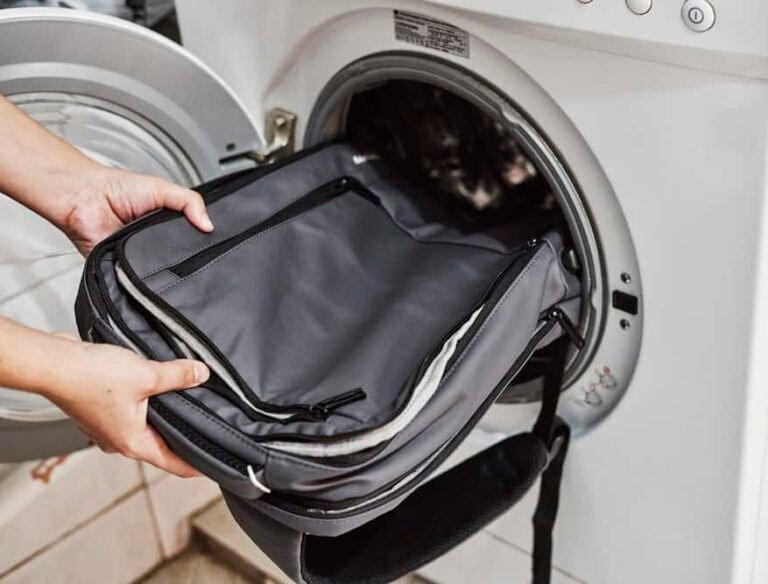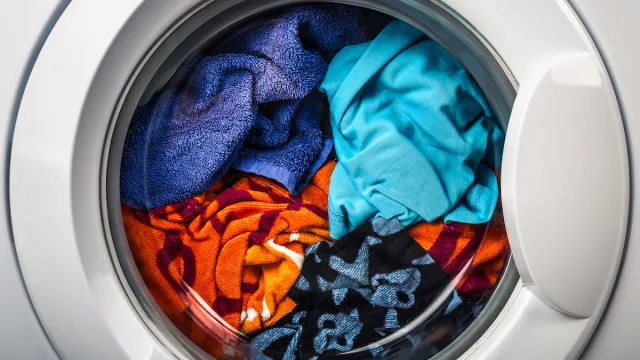Does Nylon shrink in the dryer?
Nylon, a versatile and widely used synthetic textile material, has found its way into various industries due to its remarkable properties. However, when it comes to caring for nylon fabrics, there’s a crucial consideration to keep in mind how they react to heat, particularly in dryers for drying clothes. In this article, we delve into the fascinating world of nylon fabric behavior under heat, aiming to unravel the mysteries behind if does nylon shrink in the dryer?
Does Nylon shrink?
Yes, Nylon can indeed shrink under specific conditions. As a synthetic polymer, nylon reacts to heat, causing its fibers to contract and the fabric to reduce in size.
Does Nylon shrink in the dryer?
Yes, nylon can indeed shrink in a dryer under certain conditions. Nylon is a synthetic polymer that is known for its unique properties, including its strength, elasticity, and moisture resistance. However, like many synthetic fabrics, nylon is sensitive to heat, and exposure to high temperatures, such as those found in dryers can cause it to shrink. Also for hat in the dryer can be shrinked.
Does Nylon shrink or stretch?
Yes, Nylon fibers possess the capacity for both shrinkage and stretching, contingent upon the conditions they encounter. Exposure to heat, moisture, or changing environments can lead to shrinkage, causing a reduction in size. Conversely, nylon’s inherent elasticity allows it to stretch when subjected to tension.
This dual nature makes nylon versatile and suitable for applications ranging from clothing to industrial uses, leveraging its ability to both shrink and stretch to its advantage.
What is Nylon?
Nylon is a synthetic polymer, a type of plastic that is created through a chemical process called polymerization. It was first developed by Wallace Carothers, a chemist at DuPont, in the 1930s. Nylon is known for its exceptional strength, durability, and versatility, making it suitable for a wide range of applications.
Why is Nylon Used?
Nylon is chosen for its strength, durability, and adaptability. It’s lightweight, making it great for clothing, outdoor gear, and aerospace parts. Resistant to wear and chemicals, it’s used in ropes, carpets, and industrial components. Nylon’s flexibility suits clothing and sports gear. Its heat resistance is valuable for electronics and automotive parts. Customizable for specific traits like flame resistance, it mimics natural fibers while lasting longer.
In medical devices, nylon’s biocompatibility and sterilization resilience shine. Its electrical insulation is useful in electronics. Nylon’s balance of quality and cost-effectiveness makes it widely preferred across industries.
Where is Nylon Used?
Nylon’s versatile qualities lead to its extensive use in various industries. It creates fabrics for clothing and sportswear, forms carpets and rugs, produces ropes and conveyor belts for industrial needs, and contributes to automotive parts due to its strength and lightweight nature.
Nylon’s presence extends to electronics for connectors and insulators, medical devices for biocompatibility, and sports gear like fishing lines and parachute cords. It even plays a role in household items such as zippers, toothbrush bristles, and luggage. Its versatility continues into aerospace and construction, used for cable insulation, interior components, and reinforcing concrete.
What are the Characteristics of Nylon?
Nylon exhibits distinctive characteristics that contribute to its widespread use across various applications. Its remarkable tensile strength and durability make it resistant to breaking under pressure, ensuring longevity in products.
The lightweight nature of nylon is particularly advantageous for crafting lightweight yet robust items like clothing, outdoor gear, and aerospace components. Additionally, nylon’s ability to withstand wear and abrasion over time makes it well-suited for applications such as ropes, carpets, and industrial components exposed to friction.

What are the Types of Nylon?
There are several types of nylon, each with distinct properties and applications. Some common types of nylon include:
Nylon 6:
Nylon 6, also known as polyamide 6 (PA6), is an early form of nylon. It finds applications in textiles, packaging, and automotive components.
Nylon 6,6:
Nylon 6,6 or polyamide 6,6 (PA66) is widely used due to its mechanical strength, heat resistance, and durability. It’s employed in fibers for clothing, carpets, industrial parts, and engineering plastics.
Nylon 4,6:
Nylon 4,6 balances strength and stiffness, making it suitable for applications like gears, bearings, and industrial components.
Nylon 11 and 12:
Nylon 11 and 12 offer high chemical resistance and flexibility. They are used in fuel lines, hoses, tubing, and other applications requiring chemical and impact resistance.
Bio-based and Sustainable Nylons:
Bio-based and recycled nylons, made from renewable sources or recycled materials, are gaining traction in various applications including textiles and automotive components.
Specialty Nylons:
Specialty nylons include variations like nylon 6,10 with enhanced chemical resistance, and nylon 6,12 with improved flexibility and low water absorption. These cater to specific needs in different industries.
Why Nylon Shrink in The Dryer?
Nylon fabrics consist of long chains of molecules that are held together by intermolecular forces, including hydrogen bonds. When exposed to heat, these intermolecular forces can weaken, causing the nylon molecules to move more freely. As the fabric cools down, these molecules can lock into a new, shrunken arrangement, resulting in a reduction in size. That happens to wet clothes in the dryer while drying.
The extent of shrinkage can depend on several factors, including the specific type of nylon used, the fabric’s construction (weave or knit), the temperature of the dryer, and the duration of drying. Higher temperatures and longer drying times are more likely to lead to significant shrinkage.
How much will nylon shrink?
The amount of shrinkage that nylon undergoes can vary based on factors such as the specific type of nylon, its manufacturing process, and the conditions it is exposed to. Generally, nylon fibers can experience shrinkage of around 5% to 10% when exposed to heat, moisture, or other changing environmental conditions. However, the shrinkage is often not uniform and can depend on the specific application and treatment of the nylon.
It’s important to note that nylon’s shrinkage is reversible to some extent. Once the conditions causing the shrinkage are removed, nylon can regain some of its original dimensions. Manufacturers often account for potential shrinkage when designing products that involve nylon, such as clothing or textiles, by incorporating allowances for potential changes in size.
If you have a specific application in mind, it’s recommended to consult with the manufacturer or reference technical specifications for the particular type of nylon you’re using to get more accurate information on potential shrinkage.
How much will each type of nylon shrink?
The extent of shrinkage for each type of nylon can vary, influenced by factors like the specific nylon type, its composition, manufacturing method, and environmental conditions. Generally, nylon fibers can shrink within the range of approximately 1% to 5%, and sometimes up to 10%, when exposed to heat, moisture, or changing environments.
For instance, nylon 6,6 (PA66) and nylon 6 (PA6) fibers may experience different degrees of shrinkage due to their distinct molecular structures. Specialized nylons like nylon 4,6 or bio-based variants might also exhibit specific shrinkage characteristics.
For precise information about the shrinkage potential of a particular nylon type, referring to manufacturer-provided technical specifications or industry resources is advisable. These resources can offer specific numbers on how much a specific nylon type is likely to shrink under specific conditions, providing valuable insights for planning and application purposes.
How long would it take Nylon to shrink?
The time it takes for nylon to shrink can vary based on factors like the type of nylon, environmental conditions, and treatment method. Nylon fibers can start to shrink relatively quickly when exposed to heat or moisture, often within minutes to hours, depending on temperature and humidity levels.
For instance, nylon clothing might begin to shrink in the first cycle of a dryer, which typically lasts around 30 to 60 minutes. However, full shrinkage may take a few drying cycles as nylon fibers gradually adjust. It’s important to note that nylon shrinkage is a gradual process, not sudden melting. To minimize shrinkage, following manufacturer care instructions and avoiding excessive heat or moisture exposure is advisable.
Does nylon and spandex shrink?

Yes, Nylon and spandex fibers can indeed experience shrinkage especially when subjected to heat, moisture, or changing environmental conditions. The extent of shrinkage varies based on factors like the specific type of nylon or spandex, their composition, and manufacturing processes. Typically, nylon fibers may shrink around 1% to 5%, and sometimes up to 10%, while spandex (elastane) can also undergo shrinkage, especially in heat-exposed scenarios.
However, the shrinkage can be influenced by fabric blends and care instructions. To mitigate unintended shrinkage,Read does spandex shrink in the dryer guide post for following manufacturer’s care guidelines is essential for clothing or fabrics containing nylon and spandex.
Does nylon and elastane shrink?
Yes, both nylon and elastane (also known as spandex or Lycra) fibers can indeed experience shrinkage under specific conditions. Nylon can shrink when exposed to heat, moisture, or changing environmental factors. Similarly, elastane fibers can also undergo shrinkage, especially when subjected to heat.
Is elastane same as spandex?
Yes, elastane is the same as spandex. The term “elastane” is commonly used in Europe and other parts of the world, while “spandex” is the term more commonly used in North America. Both names refer to the same synthetic fiber that is known for its exceptional stretch and recovery properties. It’s widely used in clothing, sportswear, and various other textile applications to provide flexibility and comfort.
Does 90 nylon and 10 spandex shrink?
A fabric blend consisting of 90% nylon and 10% spandex does possess the potential for shrinkage, especially when subjected to conditions like heat, moisture, or changing environments. Shrinkage can vary based on factors such as the manufacturing process, specific types of nylon and spandex, and care instructions followed. While both nylon and spandex fibers can individually experience shrinkage, the overall extent and behavior of the blend may depend on these factors.
To safeguard against unintended shrinkage, adhering to the manufacturer’s provided care instructions becomes essential for maintaining the fabric’s fit and integrity, particularly for clothing or fabrics featuring this blend.
Does 80% Nylon and 20% Spandex Shrink?
A fabric blend consisting of 80% nylon and 20% spandex might experience some shrinkage, particularly under heat or moisture. Care instructions should be followed to mitigate unwanted shrinkage.
Does 92% Nylon and 8% Elastane Fabric Shrink?
A fabric containing 92% nylon and 8% elastane (spandex) may exhibit minimal shrinkage under specific conditions, such as heat exposure. Adhering to care instructions is advisable.
Does 94% Nylon and 6% Spandex Fabric Shrink?
A fabric composed of 94% nylon and 6% spandex could potentially experience slight shrinkage, particularly under heat or moisture conditions. Adhering to care instructions can help minimize shrinkage.
Does 94% Nylon and 6% Spandex Shrink in Each Fabric?
Yes, a fabric blend of 94% nylon and 6% spandex might experience minor shrinkage, especially when exposed to heat or moisture. Following care guidelines is recommended.
Fabric 57% Nylon, 25% Wool, 15% Acrylic, 3% Spandex: Does It Shrink?
A fabric blend containing 57% nylon, 25% wool, 15% acrylic, and 3% spandex can undergo some degree of shrinkage, primarily due to the presence of wool and nylon. Heat and moisture may contribute to this effect.
Does a Cotton Nylon Blend Shrink?

Yes, a fabric blend of cotton and nylon can experience shrinkage, especially when exposed to heat or moisture. The extent of shrinkage may vary depending on the blend ratio and care instructions.
Does Polyester and Nylon Shrink?

Polyester and nylon fibers generally have low shrinkage rates compared to natural fibers like cotton. However, minimal shrinkage might occur under certain conditions.
Does a Rayon Nylon Blend Shrink?

A blend of rayon and nylon can undergo some shrinkage when exposed to heat or moisture. The extent of shrinkage may depend on the specific fabric composition.
Does 74% Rayon, 23% Nylon, and 3% Spandex Shrink?
A fabric blend of 74% rayon, 23% nylon, and 3% spandex might undergo shrinkage, especially when subjected to heat or moisture. The blend’s fiber composition can influence the extent of shrinkage.
Does 75% Rayon, 22% Nylon, and 3% Spandex Shrink?
A fabric blend of 75% rayon, 22% nylon, and 3% spandex may experience minor shrinkage when exposed to heat or moisture. The specific fabric composition can impact the degree of shrinkage.
Does Viscose and Nylon Shrink?

A viscose (rayon) and nylon blend may experience shrinkage, especially under heat or moisture exposure. The degree of shrinkage could vary based on the fabric’s composition.
Does Nylon Polyamide Shrink?
Yes, nylon (also known as polyamide or PA) fibers can shrink under certain conditions, such as heat, moisture, or changing environments.
A shirt made of 28% nylon may experience minimal shrinkage, especially under heat or moisture exposure. However, the degree of shrinkage might be relatively minor compared to fabrics with higher nylon percentages.
FAQ Does Nylon Shrink in the dryer
How Much Will Nylon Shrink?
The extent of nylon shrinkage can vary based on factors like the specific type of nylon, its composition, manufacturing process, and the conditions it’s exposed to. Generally, nylon fibers can shrink within the range of approximately 1% to 5%, and sometimes up to 10%, when exposed to heat, moisture, or changing environmental conditions.
Does Nylon Shrink Easily?
Nylon fibers are susceptible to shrinkage, especially when subjected to heat, moisture, or changing environmental conditions. Their responsiveness to these factors can lead to noticeable shrinkage, which is why proper care and adherence to manufacturer guidelines are important to maintain the fabric’s desired size.
What Temperature Does Nylon Shrink?
Nylon can begin to shrink at temperatures as low as 300°F (150°C). The shrinkage process is gradual, and higher temperatures can accelerate the effect. Care should be taken to avoid subjecting nylon fabrics to excessive heat, especially if the intention is to preserve their original dimensions.
Does Heat Ruin Nylon?
Excessive heat can potentially damage nylon fibers. While nylon is relatively heat-resistant, subjecting it to very high temperatures can lead to changes in its structure and properties. This can result in shrinkage, loss of strength, and altered appearance. It’s recommended to follow care instructions to prevent heat-related damage.
Does Heat Damage Nylon?
Yes, heat can damage nylon if exposed to excessive temperatures. Nylon fibers can undergo structural changes, leading to shrinkage, loss of strength, and potential alteration of its original properties. To preserve the integrity of nylon fabrics, avoiding prolonged exposure to high heat is advisable.
Conclusion
Does nylon shrink in the dryer? Understanding the effects of heat on nylon fabrics is crucial for extending the lifespan of clothing and products. By grasping the mechanisms behind nylon shrinkage in dryers, consumers, manufacturers, and retailers can make informed decisions. As we continue to explore the world of fabric engineering, finding ways to mitigate shrinkage while maximizing nylon’s beneficial properties remains an ongoing challenge.







